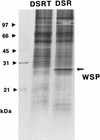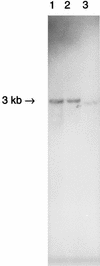Cloning and characterization of a gene encoding the major surface protein of the bacterial endosymbiont Wolbachia pipientis
- PMID: 9573188
- PMCID: PMC107178
- DOI: 10.1128/JB.180.9.2373-2378.1998
Cloning and characterization of a gene encoding the major surface protein of the bacterial endosymbiont Wolbachia pipientis
Abstract
The maternally inherited intracellular symbiont Wolbachia pipientis is well known for inducing a variety of reproductive abnormalities in the diverse arthropod hosts it infects. It has been implicated in causing cytoplasmic incompatibility, parthenogenesis, and the feminization of genetic males in different hosts. The molecular mechanisms by which this fastidious intracellular bacterium causes these reproductive and developmental abnormalities have not yet been determined. In this paper, we report on (i) the purification of one of the most abundantly expressed Wolbachia proteins from infected Drosophila eggs and (ii) the subsequent cloning and characterization of the gene (wsp) that encodes it. The functionality of the wsp promoter region was also successfully tested in Escherichia coli. Comparison of sequences of this gene from different strains of Wolbachia revealed a high level of variability. This sequence variation correlated with the ability of certain Wolbachia strains to induce or rescue the cytoplasmic incompatibility phenotype in infected insects. As such, this gene will be a very useful tool for Wolbachia strain typing and phylogenetic analysis, as well as understanding the molecular basis of the interaction of Wolbachia with its host.
Figures






References
-
- Beard C B, O’Neill S L, Tesh R B, Richards F F, Aksoy S. Modification of arthropod vector competence via symbiotic bacteria. Parasitol Today. 1993;9:179–183. - PubMed
-
- Bjerrum O J, Schafer-Nielsen C. Buffer systems and transfer parameters for semidry electroblotting with a horizontal apparatus. In: Dunn M J, editor. Electrophoresis 86. Weinheim, Germany: VCH; 1986. pp. 315–327.
-
- Bourtzis K, Dobson S L, Braig H R, O’Neill S L. Rescuing Wolbachia have been overlooked. Nature. 1998;391:852–853. - PubMed
-
- Brower J H. Cytoplasmic incompatibility: occurrence in a stored product pest Ephestia cautella. Ann Entomol Soc Am. 1976;69:1011–1015.
-
- Chart H. Bacterial fractionation and membrane protein characterization. In: Chart H, editor. Methods in practical laboratory bacteriology. Boca Raton, Fla: CRC Press; 1994. pp. 1–10.
Publication types
MeSH terms
Substances
Associated data
- Actions
- Actions
- Actions
- Actions
- Actions
- Actions
- Actions
Grants and funding
LinkOut - more resources
Full Text Sources
Molecular Biology Databases
Research Materials

